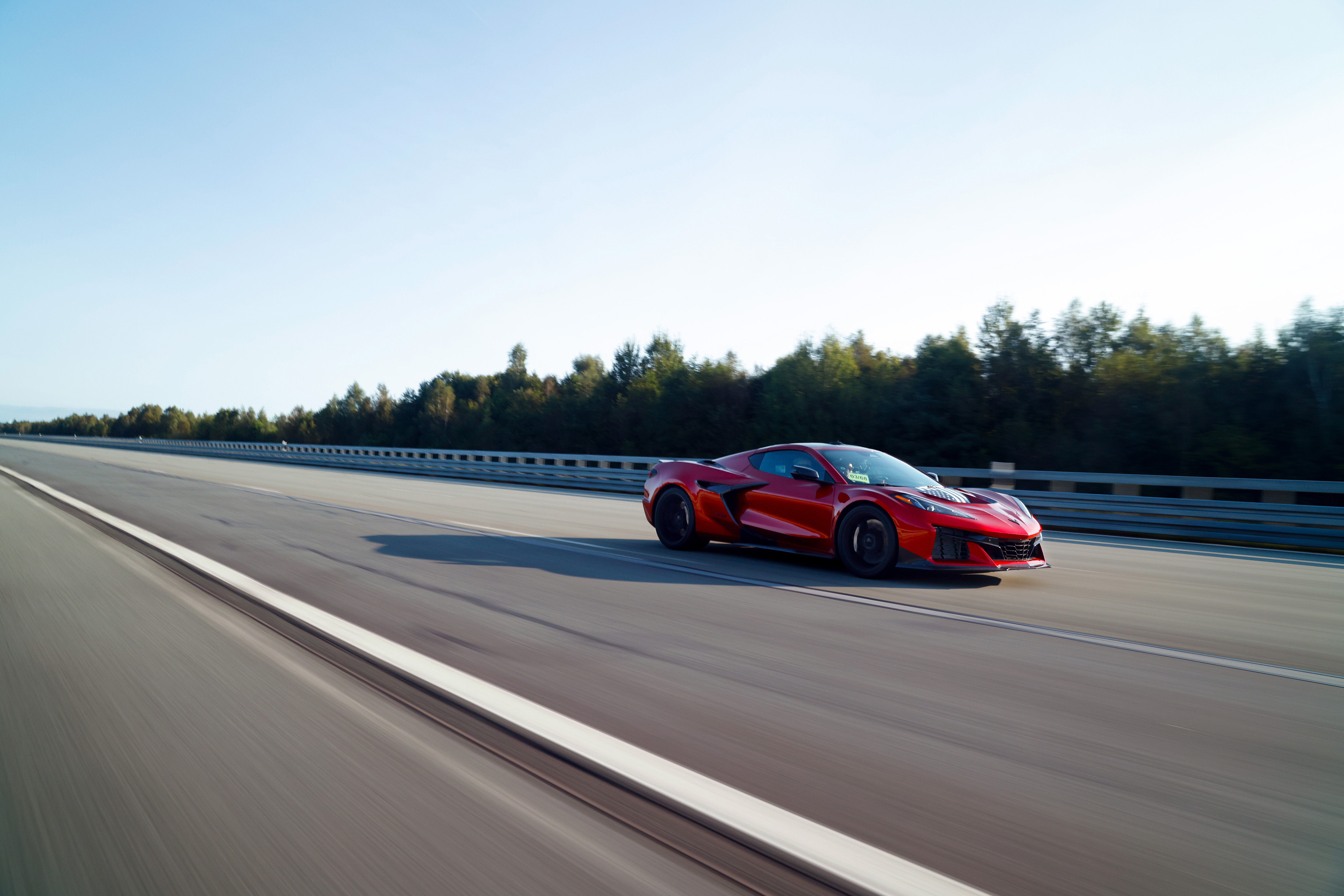A New American Legend: The 2025 Corvette ZR1 Rewrites Speed History
Jo-Carolyn Goode | 10/15/2024, 10:57 a.m.

The roar of an engine cutting through the crisp air, the blur of steel slicing across a legendary track in Germany, and in the driver's seat—none other than General Motors President Mark Reuss. Sounds like the plot of a high-octane action film, right? Well, buckle up, because this isn't a movie—it's real life, and the 2025 Chevrolet Corvette ZR1 is rewriting automotive history.
On a test track in Papenburg, Germany, Mark Reuss piloted the all-new Corvette ZR1 to an astonishing 233 mph, a feat that makes this car the fastest production vehicle ever built by an American automaker. And, what’s even more jaw-dropping? The ZR1, with its fiery twin-turbo V8, sets this speed record at a price well under the million-dollar mark. Move over, Bugatti and Koenigsegg, because Corvette is stealing the spotlight.
 At 233 mph, the 2025 Chevrolet Corvette ZR1 is now the fastest car ever built by an American auto manufacturer. Preproduction model shown. Actual production model may vary.
At 233 mph, the 2025 Chevrolet Corvette ZR1 is now the fastest car ever built by an American auto manufacturer. Preproduction model shown. Actual production model may vary.MATT BEARD
The Road to 233 MPH
Let’s set the stage: It was a crisp day on the high-speed oval at ATP Automotive Testing in Papenburg. With butterflies in his stomach and horsepower beneath his feet, Reuss took the 2025 Corvette ZR1 on the ride of a lifetime. This wasn’t just a lucky one-time sprint either; the record-breaking speed was clocked during a two-way average run, cementing it as no fluke. And for all you gearheads out there, the ZR1 was in “Top Speed Mode,” a feature meticulously developed by Chevrolet engineers to tweak the chassis and maximize performance.
“We knew the mid-engine layout of the new-generation Corvette unlocked an entirely new level of performance," said Reuss, who called the experience "surreal." His enthusiasm is understandable—he’s just taken one of the world’s most iconic cars to heights no one thought possible for an American vehicle.
But Reuss wasn’t flying solo. Riding shotgun, an engineer diligently monitored the vehicle’s performance, analyzing data in real time—because when you’re chasing history, every second and every metric matters.
Power Meets Precision
Under the hood of the Corvette ZR1 sits an absolute beast: a 5.5L, twin-turbocharged LT7 DOHC V8 engine, capable of pushing a mind-bending 1,064 horsepower at 7,000 rpm. This is the most powerful V8 engine ever to come out of an American factory, and it shows. Producing 828 lb-ft of torque, the ZR1 is built not just for speed, but for total domination of the road. With its flat-plane crank, it's as smooth as it is savage, propelling this beast to a sub-10-second quarter mile—a number more typically reserved for high-performance drag cars.
If you’re thinking it’s all about brute force, think again. The Corvette ZR1 is an engineering marvel. It boasts a carbon fiber aero package that generates over 1,200 pounds of downforce at top speed. This isn’t just about going fast—it’s about staying glued to the pavement while you do it. And for fans of vintage design, the ZR1 is also a nod to Corvette’s roots with its revived split rear window, a style that first stole hearts in 1963.
 General Motors President Mark Reuss
General Motors President Mark ReussEngineering Mastery on Full Display
The ZR1’s record-setting run in Germany was no small feat, and it wasn’t just about horsepower and aerodynamics. It was about Chevrolet's commitment to innovation and engineering excellence. The car’s Michelin Pilot Sport 4S tires, aluminum wheels, and carbon fiber ground effects all worked in harmony to provide unparalleled stability and control at breakneck speeds. Papenburg, with its cool temperatures and optimal air density, was the perfect testing ground for Chevrolet engineers, who had previously set top speeds for both the sixth and seventh-generation Corvette ZR1s at the same facility.
A Legacy of American Innovation
When we think of supercars, names like Ferrari, Lamborghini, and Bugatti often dominate the conversation. But Chevrolet is out to prove that American muscle has not only kept pace but now leads the race. With the 2025 ZR1, Chevrolet is sending a clear message: You don’t have to spend a million dollars to own a world-class supercar.
Chevrolet’s accomplishment with the ZR1 is a testament to the power of American engineering and the relentless pursuit of speed. This isn’t just another car off the assembly line—this is a high-tech, meticulously crafted machine that combines raw power with cutting-edge aerodynamics and precision handling.
And in case you’re not convinced by the numbers alone, there’s more. Chevrolet has released a mini-documentary about the ZR1’s record-breaking run. Watch it on YouTube to see the ZR1 in action, or keep up with the latest news on Corvette’s Instagram, Facebook, and TikTok channels.
The Future of American Performance
With the 2025 Corvette ZR1, GM isn’t just making cars—they’re making statements. The ZR1 is living proof that American automakers can hang with the best of them, and then some. Whether you’re a Corvette enthusiast or simply someone who appreciates the fusion of power and precision, this car is a glimpse into the future of what’s possible in American manufacturing. And while the ZR1 stands out for its gas-powered dominance, GM’s broader portfolio, including its expanding range of EVs, shows a brand ready to lead the charge into a new era of innovation.
So if you’re in the market for speed, performance, and history in the making, look no further than the Corvette ZR1—the fastest production car America has ever built.
Key Features at a Glance:
Engine: 5.5L twin-turbocharged LT7 DOHC V8
Power: 1,064 horsepower at 7,000 rpm
Torque* 828 lb-ft at 6,000 rpm
Top Speed: 233 mph
Aerodynamics: Carbon fiber package with 1,200 pounds of downforce
Design: Split rear window revival
Now, if that doesn’t rev your engine, we don’t know what will.
For more info, visit chevrolet.com



